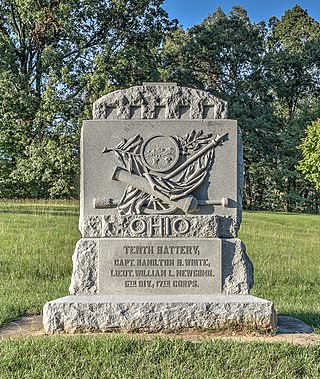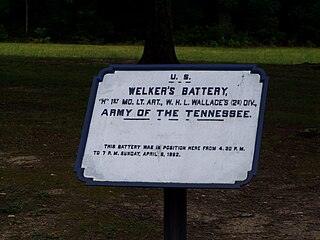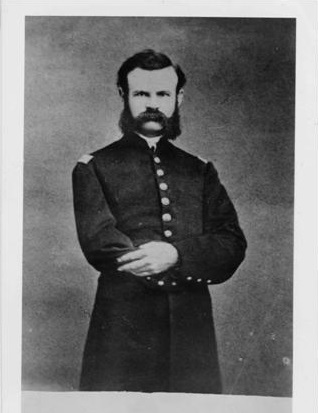5th Ohio Battery was an artillery battery that served in the Union Army during the American Civil War.

10th Ohio Battery was an artillery battery that served in the Union Army during the American Civil War.
The 11th Ohio Battery was an artillery battery that served in the Union Army during the American Civil War.
3rd Indiana Battery Light Artillery was an artillery battery that served in the Union Army during the American Civil War.
9th Indiana Battery Light Artillery was an artillery battery that served in the Union Army during the American Civil War.
14th Indiana Battery Light Artillery was an artillery battery that served in the Union Army during the American Civil War.

Bissell's Engineer Regiment, also known as Bissell's Engineer Regiment of the West, was an engineer regiment that served in the Union Army during the American Civil War.
The 21st Missouri Infantry Regiment was an infantry regiment that served in the Union Army during the American Civil War.
The 11th Missouri Infantry Regiment was an infantry regiment that served in the Union Army during the American Civil War.
Battery H, 1st Illinois Light Artillery Regiment, was an artillery battery that served in the Union Army during the American Civil War.
Battery C, 1st Missouri Light Artillery Regiment, also known as Mann's Independent Missouri Battery, was an artillery battery that served in the Union Army during the American Civil War. Organized between November 1861 and February 1862, Mann's Independent Battery fought at Shiloh and in the Corinth siege. After its name changed to Battery C, 1st Missouri in August 1862, it fought at Hatchie's Bridge, the Vicksburg campaign, the Meridian campaign, and the Atlanta campaign. In November 1864, the battery was assigned to the Nashville garrison; it remained there until it was mustered out in July 1865.
Battery D, 1st Missouri Light Artillery Regiment was an artillery battery that served in the Union Army during the American Civil War. Organized before February 1862, Battery D fought at Fort Henry, Fort Donelson, Shiloh, Corinth siege, Corinth, and Missionary Ridge. After serving in the Knoxville campaign, the battery garrisoned Huntsville, Alabama until April 1865. At that time it was consolidated with Battery C, 1st Missouri Light Artillery Regiment which was mustered out in July 1865.
Battery I, 1st Missouri Light Artillery Regiment, also known as Buel's Independent Missouri Battery, was an artillery battery that served in the Union Army during the American Civil War. Organized in July 1861, Buell's Independent Battery fought at Shiloh and in the Corinth siege. After its name changed to Battery I, 1st Missouri Light Artillery Regiment in August 1862, it fought at Corinth, in operations supporting Streight's Raid, at Resaca, and at Rome Cross Roads before being assigned to the Nashville garrison. It fought at the Battle of Nashville and was mustered out in June 1865.
Wade's Battery was an artillery battery in the Confederate States Army during the American Civil War. The battery was mustered into Confederate service on December 28, 1861; many of the members of the battery had previously served in the Missouri State Guard. Assigned to the First Missouri Brigade, the battery saw action at the Battle of Pea Ridge and the Second Battle of Corinth in 1862. In 1863, the battery fought at the Battle of Grand Gulf, where Captain William Wade, first commander of the battery, was killed. The battery later saw action at the Battle of Champion Hill, Battle of Big Black River Bridge, and the Siege of Vicksburg. When the Confederates surrendered at the end of the Siege of Vicksburg, the men of the battery became prisoners of war. After a prisoner exchange, the men of the battery were combined with Landis's Battery and Guibor's Battery on October 3, 1863, and Wade's Battery ceased to exist as a separate unit.

Battery F, 1st Missouri Light Artillery Regiment was an artillery battery unit from Missouri that served in the Union Army during the American Civil War. The battery participated in operations in December 1861. Battery F fought at the battles of Prairie Grove and Van Buren in December 1862. The battery fought at Vicksburg, Brownsville, Mustang Island, and Fort Esperanza in 1863. The unit fought at Spanish Fort, and Fort Blakely in 1865. Battery F was mustered out on 11 August 1865.

Battery K, 1st Missouri Light Artillery Regiment was an artillery battery unit from Missouri that served in the Union Army during the American Civil War. The 1st Missouri Light Artillery Regiment was formed 1 September 1861. Battery K fought at Fort Henry, Fort Donelson, Shiloh, 1st Corinth, and 2nd Corinth in 1862. The unit was in action at Helena and Bayou Fourche in 1863. Battery K performed garrison and occupation duty at Little Rock, Arkansas in 1863–1865 before being mustered out on 4 August 1865.

Battery H, 1st Missouri Light Artillery Regiment was an artillery battery unit from Missouri that served in the Union Army during the American Civil War. The 1st Missouri Light Artillery Regiment was created on 1 September 1861. Battery H fought at Fort Henry, Fort Donelson, Shiloh, 1st Corinth, and 2nd Corinth in 1862. The battery performed mostly garrison duty in 1863. The unit was in action in the Atlanta campaign and Sherman's March to the Sea in 1864 and in the Carolinas campaign in 1865. Battery H marched in the Grand Review of the Armies before being mustered out on 16 June 1865.

Battery I, 1st Illinois Light Artillery Regiment was an artillery battery from Illinois that served in the Union Army during the American Civil War. The battery was organized in February 1862 at Chicago and within two months it fought at Shiloh. Later, the battery served at Corinth, Vicksburg, Jackson, Missionary Ridge, Knoxville, Franklin, and Nashville. The battery mustered out of Federal service in July 1865.

Battery F, 2nd Illinois Light Artillery Regiment was an artillery battery from Illinois that served in the Union Army during the American Civil War. The battery was organized in December 1861 at Cape Girardeau, Missouri. The unit fought at Shiloh, First Corinth, and Second Corinth in 1862 and at Vicksburg and Jackson in 1863. The battery served in the Atlanta campaign and at Nashville in 1864. It was mustered out of federal service in July 1865. The battery's first commander was John Wesley Powell who later led an exploration of the Grand Canyon.

Battery G, 2nd Illinois Light Artillery Regiment was an artillery battery from Illinois that served in the Union Army during the American Civil War. The battery was organized at the end of December 1861. It fought at Vicksburg in 1863, Tupelo and Nashville in 1864, and Spanish Fort and Fort Blakeley in 1865. The battery was mustered out in September 1865.








